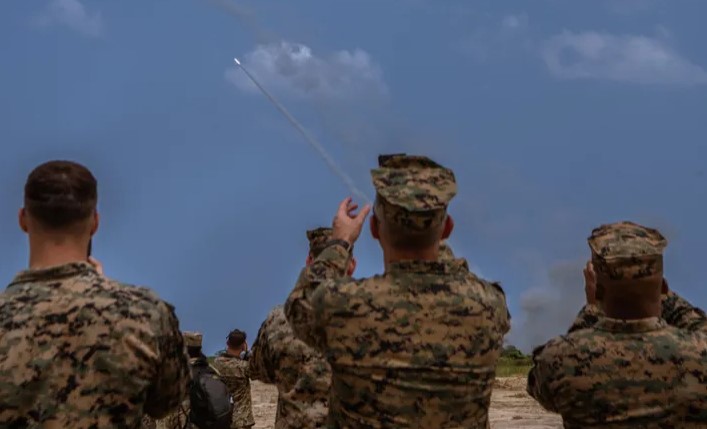
By Rowaida Abdelaziz
From Huffington Post | Original Article
The U.S. government has long celebrated having immigrants in the military, but Sofya Aptekar’s new book shows it’s a much more complicated story.
The U.S. government has long celebrated having immigrants in the military and has touted the 158,000 people who have earned citizenship through service since 2002.
More than 10,600 service members were naturalized during a one-year period ending last September alone. To become eligible to apply for naturalization, an immigrant must have served honorably for a minimum of a year and have a certain immigration status at the time of the naturalization interview, among other requirements.
But immigrants in the military have also reported delayed timelines for the naturalization process and long periods of being trapped in bureaucratic limbo; some U.S. veterans have even been deported.
Sofya Aptekar, an associate professor at the City University of New York School of Labor and Urban Studies, takes a critical look at how the U.S. military uses the promise of citizenship to recruit immigrants under false premises. For her new book, “Green Card Soldier: Between Model Immigrant and Security Threat,” which is coming out next month, she interviewed more than 70 noncitizen soldiers from 23 countries.
Aptekar talked to HuffPost about her findings, the role of stereotypes in recruitment and the historical role the U.S. military has played regarding migration, labor and exploitation.
Talk to me about the inspiration for this book. What made you want to write it?
My first book, “The Road to Citizenship: What Naturalization Means for Immigrants and the United States,” was looking at the naturalization process and what it was like for immigrants and what it meant to them. As a part of that work, I touched a little bit on naturalization for military service as this separate, special route for those who worked in the military. But I didn’t develop it. It was always in the back of my mind.
I was chatting with a colleague some years later who does work on deportations, and he was sharing this really kind of disturbing experience where he was presenting in a border town, just north of Mexico. He was doing an academic talk when a group of men stood up at the end of the talk in the back of the room and unfurled a huge banner that said, “Bring Deported Veterans Home.”
I was like, “Wow, I really need to look into it more,” and of course, deported veterans were one part of the story, but that was kind of my way back into that work and looking at the experience of immigrants from the military.
You open your book with a story about a man named Miguel, a Peruvian American who was stationed along the U.S.-Mexico border. While he was there, Miguel described how he felt a “kinship with fellow Indigenous people of the continent” and how they looked like his dad, and they looked like him. You wrote that “he found that he had more in common with them than what he called the average American.”
How do immigrant military members process such internal conflict and how does it impact how they perceive the U.S. military and the country as a whole?
Miguel is such a good example because he was so good at explaining how he changed over time, his understanding of the U.S. and the way he was shaped by his experience in the U.S. military.
He talked to me about the stress he felt imagining that he would be put in the position of shooting a migrant when he was a migrant. That did not make him feel any more American. It also took a long time for him to become naturalized. He lived in Peru for a while after service in the military because he was not so sure that he wanted to live in the U.S. [but eventually] he came back and he embraced being an American.
It is such a much more complicated story than what we often hear, which is celebrating immigrants serving in the military as proof that they really want to be Americans, and look how great it is. That is not that common of a story.
Half of all military recruits by the 1840s were born outside the United States, and Native Americans had the highest rates of any racial group enlisting in the U.S. military. From a historical perspective, how have things changed — or not — when it comes to those experiences and the experiences of Black members and other marginalized groups?
The U.S. military is not unique [when it comes to] the general trend of imperial militaries using marginalized or colonized populations as military labor. That’s what happened in the U.S., and it’s not that different from Britain and what it did for example, in places like India.
For Native Americans, these young people were cut off from their culture and their family members, and that created a stream into the military that has stayed. So that’s part of the story.
The other part of the story is drafts. Multiple times in U.S. history, drafts were avoided by expanding who was allowed to serve in the military and allowing wealthier people to avoid sending their youth for military service. Part of why we see so many immigrants and oppressed groups serving in the military is because of that, because their serving means wealthy, white people don’t have to serve.
In the public sphere, the narrative is that service in the military led to even more rights for African Americans and that the military is a colorblind institution, it’s the one institution in the U.S. where racism is not as prevalent. And that’s really the wrong way of looking at it. There are plenty of statistics that show that racial discrimination against African Americans is present in so many areas — promotions, military justice, who is in the military prisons, exposure to combat, etc.
“Part of why we see so many immigrants and oppressed groups serving in the military is … because their serving means wealthy, white people don’t have to serve.”
Another thing that I write about in my book that’s very striking that I learned when I was writing it is that after African American veterans came back from World War II, there were some of the highest rates of lynchings.
The idea at the time was that white people would view [African Americans] after they served their nation as equal, but in fact, they [were seen as] a threat because they had experience and they were a threat to the prevailing racial order, and they needed to be violently put down. That’s actually what happened after World War II. It’s very scary and tragic.
With that type of history, have you seen an increase in different racial groups enlisting, or has it just kind of been the same throughout the different wars?
The immigrant population in the military doesn’t look like the general population. Some are overrepresented. For example, Filipinos are a higher percentage than they are in the general population because of the legacy of U.S. imperialism in the Philippines.
Starting in 2009, after the creation of the Military Accessions Vital to the National Interest (a recruiting program that allows certain noncitizens to join the U.S. military and apply immediately for U.S. citizenship), there was an influx of recent immigrants, mostly college students. It was a different and new thing that hadn’t been really happening before because most immigrants in the military had grown up in the U.S.
I’m glad you brought up the college student anecdote because the one thing that I found interesting in your book is where you noted “Proposals to make college free are also seen as a threat to military recruitment. ” Earlier this year, the Biden administration fought hard for tuition-free community college but received vehement pushback. How do you think that will bode for the military and people interested in enlisting?
Recruitment is not doing well right now. I fully anticipate that if college is free and debt is completely canceled, as it should be, that will severely undermine the military’s ability to get people to enlist — even as they continue to change the requirements [to] make it easier to enlist, such as raising the age and giving a lot of waivers for people with criminal records.
I want to pivot the conversation to talk a little about the role of stereotypes. You talked about the portrayal of Central American migrant men in particular and how they were depicted as violent gang members. But at the same time, that same stereotype of the hyper-masculine man was the same reason recruiters said those qualities made them well suited to join to only have that backfire because they were put in dangerous military positions.
Is that still quite common? Are there other similar stereotypes that you’ve seen with other groups as well?
I’m glad you picked up on that because to me the whole masculinity and gender aspect is fascinating. I was able to interview people from so many different countries across the world, and people are racialized differently. There is this powerful stereotype that really reduces the humanity of these men. It flattens what they can be as people in ways that harm them and also harm their victims, as they are foot soldiers sometimes in the same regions that they came from.
The difference with Central American men — but also with Latinx men in general — and the contrast with Asian men is really striking. The U.S. stereotype of Asian men is one of lacking masculinity or being deficient in masculinity, and the military service was an attempt to correct that and attempt to acquire these layers of warrior masculinities to repair the damage that they suffered to their images as Asian men specifically.
The military definitely capitalizes on that and seeds it and grows it sends it out in the world and back into the communities.
Was there any particular individual or story that you met that resonated with you from your book?
Miguel’s — that’s why I put him first. He’s also a neighbor.
We were both active in a neighborhood group that just did organizing around workers’ rights. I had already started the project, which was going very slow. I had learned that he was a veteran and that he was a noncitizen who enlisted. He was very generous. We had this beautiful conversation in a local coffee shop.
